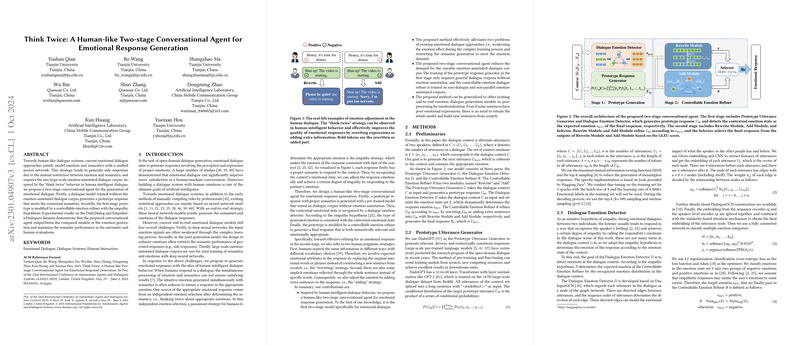Analysis of "Think Twice: A Human-like Two-stage Conversational Agent for Emotional Response Generation"
The paper "Think Twice: A Human-like Two-stage Conversational Agent for Emotional Response Generation" presents a novel approach to enhance the emotional intelligence of conversational agents by employing a two-stage generation process. This method diverges from the conventional end-to-end emotional dialogue systems which often grapple with the simultaneous management of emotion and semantics, leading to generic dialogues due to the inherent conflict and complexity in processing both simultaneously.
Methodology and Model Architecture
The core innovation of the proposed method lies in its two-stage generation process inspired by human-like dialogue behavior. Initially, a prototype response is generated that addresses the semantic context of the dialogue without relying on emotionally annotated data. This circumvents the scarcity of large-scale emotion-annotated conversational datasets. Subsequently, the second stage involves refining this prototype response through a controllable emotion refiner, ensuring the emotional appropriateness of responses. This separation of semantic and emotional processing aims to alleviate the restrictions between emotion and semantics observed in joint models, thereby enhancing both semantic relevance and emotional expressiveness.
The model employs a Dialogue Emotion Detector, which estimates the emotional state from dialogue context, leveraging the empathy hypothesis where responses are empathically aligned with the emotions detected in prior dialogue turns. The emotion refinement utilizes two pragmatic human strategies, namely "rewriting" and "adding," to adjust the emotional tone by either replacing or appending emotional content to the initial prototype response.
Experimental Evaluation
The efficacy of the proposed model is substantiated through experiments on the DailyDialog and EmpatheticDialogues datasets. The results evidenced an improved emotional generation capacity while maintaining semantic consistency. Objective metrics such as BLEU and GLEU, along with subjective human evaluations, were employed, showing remarkably enhanced diversity and emotional authenticity of responses compared to baselines.
Key Contributions and Implications
- Model Contributions:
- Introduces a pioneering two-stage framework specifically designed for emotional dialogue responses.
- Effectively separates semantic generation from emotional refinement, enhancing the overall dialogue quality.
- Demonstrates the significance of empathy-driven response modifications, aligning with human dialogue strategies.
- Implications for Emotionally Intelligent Systems:
- Suggests scalable solutions for building emotionally-aware conversational agents without exhaustive emotion-annotated datasets.
- Offers insights into constructing modular dialogue systems where emotion can be dynamically tuned post initial semantic generation.
- Broader Impact:
- Models like the proposed agent can find applications in user-centric AI systems, potentially improving user satisfaction in customer service, therapy, and personal assistant domains.
Future Work
The paper suggests the exploration of further dimensions such as domain adaptation and style exploration in dialogue systems, which could be included as additional layers or factors in the post-generation refinement stage. Investigating adaptive techniques to predict and balance explicit and implicit emotional expressions remains a fertile ground for future research.
In summary, this paper elucidates a substantial step toward more sophisticated, emotionally intelligent conversational agents by effectively bifurcating the generation processes for semantics and emotions. This contributes to the capabilities of AI in more nuanced, human-like interactions.
